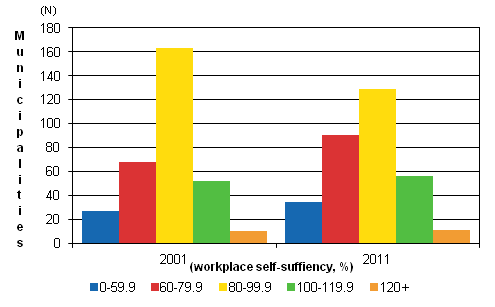Published: 9 October 2013
One-fifth of municipalities have over 100 per cent workplace self-sufficiency
According to Statistics Finland's employment statistics, workplace self-sufficiency increased in 39 per cent of municipalities and decreased in 60 per cent of municipalities in 2011 compared to the figures ten years ago. The highest workplace self-sufficiency in Mainland Finland was found in Harjavalta (133.7%), Pietarsaari (132.7%) and Helsinki (130.8%). Workplace self-sufficiency in Mainland Finland was lowest in Pornainen (42.8%), Vesilahti (44.2%) and Lemi (45.9%). Workplace self-sufficiency exceeded 100 per cent in 67 municipalities.
Number of municipalities by workplace self-sufficiency in 2001 and 2011

Workplace self-sufficiency indicates the relationship between the number of employees (jobs) in a particular area and the number of employed persons living in the area. The basis for workplace self-sufficiency in the new Municipal Structures Act (478/2013) differs from the workplace self-sufficiency concept used in this review. If workplace self-sufficiency exceeds 100 per cent, the number of jobs in the municipality is higher than the number of employed persons living in the municipality.
In 2011, workplace self-sufficiency exceeded 100 per cent in 67 municipalities (20.9% of all municipalities). Ten years ago the 100 per cent limit was exceeded by five fewer municipalities. In the municipalities that had over 100 per cent workplace self-sufficiency in 2001, the workplace self-sufficiency had increased further over the past ten years in 61.3 per cent of the municipalities. The 2013 municipal borders are used for both comparison years: there is a total of 320 municipalities.
In 2011, workplace self-sufficiency was under 60 per cent in 34 municipalities (10.6%). Ten years ago, 27 municipalities were below the 60 per cent limit (8.4%). In ten years, the number of municipalities decreased by 34 municipalities in the category where workplace self-sufficiency was between 80 and 100 per cent. By contrast, the number of municipalities in the workplace self-sufficiency category of 60 to 80 per cent grew by 22. The development of workplace self-sufficiency indicates stronger concentrations of workplaces and increased commuting.
Helsinki number one among large municipalities, Pyhäntä among small municipalities
In 2011, the highest workplace self-sufficiency in towns with over 50,000 inhabitants was found in Helsinki (130.8%), Vaasa (128.1%) and Tampere (123.1%). Among the largest towns, workplace self-sufficiency weakened compared to the figures of 2001 in five towns and the biggest decline was seen in Salo (by 3.1 percentage points). Vantaa (7.3 percentage points) and Joensuu (6.5 percentage points) increased their workplace self-sufficiency most. Lowest workplace self-sufficiency was found in Espoo (96.5%), Kouvola (97.0%) and Rovaniemi (99.8%). Among the twenty largest towns, workplace self-sufficiency exceeded 100 per cent in 17 towns in 2011.
In 2011, there were 36 municipalities with more inhabitants than 20,000 but fewer than 50,000, of which highest workplace self-sufficiency was found in Kemi (119.0%), Raahe (116.8%) and Varkaus (109.5%). Workplace self-sufficiency decreased in more than one-half of these municipalities compared to the figures of 2001. Workplace self-sufficiency was lowest in Kirkkonummi (60.1%), Nurmijärvi (60.7%) and Vihti (60.8%).
There were 47 municipalities with 10,000 to 20,000 inhabitants. In around one-half of the municipalities in this size category, workplace self-sufficiency decreased compared to 2001. In 2011, workplace self-sufficiency was highest in Mariehamn (177.8%), Pietarsaari (132.7%) and Forssa (122.2%). Workplace self-sufficiency was lowest in Mustasaari (54.2%), Sipoo (57.1%) and Kontiolahti (62.7%). There was much commuting from these municipalities to towns nearby.
There were 102 municipalities in the size category of 4,000 to 10,000 inhabitants. In this group of municipalities, highest workplace self-sufficiency was found in Harjavalta (133.7%), Säkylä (130.4%) and Sievi (123.9%), and the lowest in Pornainen (42.8%), Vesilahti (44.2%) and Luoto (46.7%). In Harjavalta, the workplace self-sufficiency was highest in Mainland Finland (133.7%). Compared to the situation ten years ago, workplace self-sufficiency decreased in 64.7 per cent of the municipalities in this size category.
A majority of municipalities or 115 municipalities (36.0%) belong to the size category of under 4,000 inhabitants. Among small municipalities, workplace self-sufficiency was highest in Pyhäntä (125.0%), Vieremä (117.3%) and Keitele (112.6%). In this group, the municipalities with the lowest workplace self-sufficiency were found in Åland. In Mainland Finland, the figures were lowest in Lemi (53.5%), Köyliö (53.3%) and Luvia (53.7%). In this group, workplace self-sufficiency decreased in 67.0 per cent of the municipalities compared to 2001.
Source: Employment Statistics, Statistics Finland
Inquiries: Jaana Huhta 09 1734 2632, tyossakaynti@stat.fi
Director in charge: Riitta Harala
Publication in pdf-format (359.5 kB)
- Tables
-
Tables in databases
Pick the data you need into tables, view the data as graphs, or download the data for your use.
Appendix tables
- Figures
Updated 9.10.2013
Official Statistics of Finland (OSF):
Employment [e-publication].
ISSN=2323-6825. Background information on unemployed persons 2011. Helsinki: Statistics Finland [referred: 19.12.2025].
Access method: http://stat.fi/til/tyokay/2011/03/tyokay_2011_03_2013-10-09_tie_001_en.html

